Dealing with the truth isn’t always an easy job. But your best product can get lost on the way without a solid network to confirm its value. This is why investing in strong professional relationships and building a powerful audience around your products is something that deserves your best attention. And while this is a troublesome process in itself, gathering the most pertinent solutions isn’t a walk in the park either.
Almost a third of the B2B marketers admitted that their posts are rather company focused than customer-centric. Networking is about creating a personal experience rather than repeating a robotic message over and over again.
A short explanation for relationship marketing is that it focuses rather on the long-term objectives that build solid engagement than on immediate profit based on one-time acquisitions. We’re about to present to you the most powerful relationship marketing articles, carefully collected by us. The purpose is to ease you into the overall marketing relationship perspective we should all be adopting when trying to promote our products and services.

1. 5 Steps to Relationship Marketing Success
Fix the Communication Link Between You and Your Website; You and Your Customer
Rosalia Cefalu talks about building a loyal community that will increase your revenue. The 5 steps to relationship marketing success start with being aware that what your customers care about most is their needs. There is nothing you can do on the long run without constant interaction and responsible concern. Provide value, engage your audience and don’t dare to make this relationship about yourself – it’s not. It’s about your customer, their passions, their wishes, their habits and you getting to know them like the back of your hand.
2. This Is the Most Important Word when It Comes to Relationship Marketing
Create an Emotional Connection with the Customer
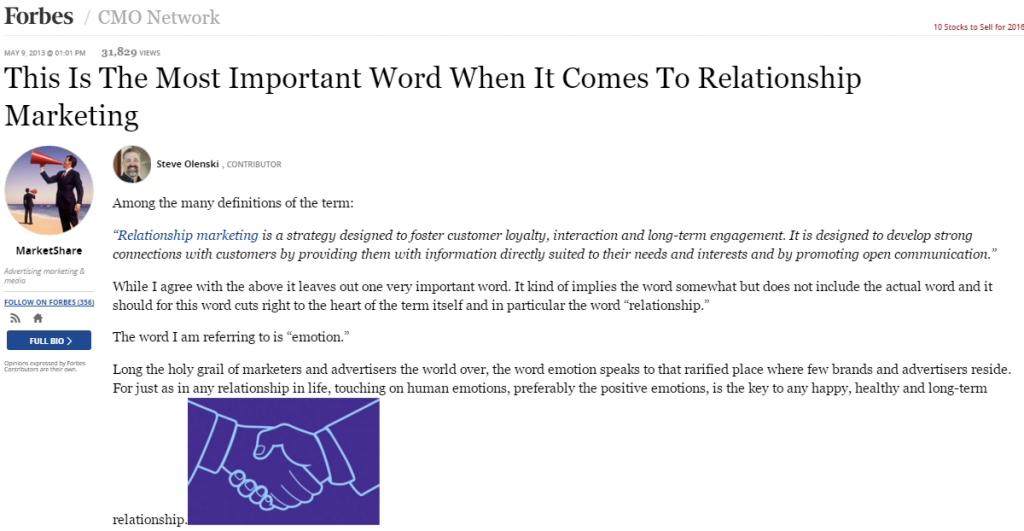
Steve Olenski interviews Jay Deutsch, CEO of BDA, one of the largest branded merchandise agency. The interviews focuses on the ultimate purpose of branding and fostering customer loyalty. Cultural experiences and virality makes it easier to focus on creating an emotional impact on your customer. The value of branded merchandise lies in making the competitive advantages stand out, while helping your customers create powerful experiences. Ultimately, your brand – as intangible as it is – is what is remembered from those experiences. This is why ’emotion’ seems to be the most important word in relationship marketing.
3. 7 Relationship-Building Strategies for Your Business
Make Your Company Indispensable; Build a Solid Two-Way Communication
Kim T. Gordon clearly frowns upon communicating with prospects and customers just for special sales. Instead, she advises to reach out to your target as often as you can, without being spammy. She recommends reward programs and special events to enhance customer loyalty. Make your customers’ problems a top priority – contribute to their experience and launch multicultural programs to stir up your marketing efforts. From time to time, don’t forget to go beyond standard sales calls and actually visit your trenches.
4. 12 Tenets of Relationship Marketing Effectiveness
Conduct Regular Pols and Monitor Social Media; High-Tech Goes Best with High-Touch
Mari Smith writes about the importance of understanding the perpetual needs and challenges of our market. Generating warm leads is impossible without being active on all social media platforms. A reliable customer relationship management strategy comes with a personal approach and a very high customer satisfaction rate. There are no best practices without consistent information about your customers. Never underestimate how important it is to integrate customer feedback into your future development strategies.
5. The 7 Secrets to Strategic Marketing Success on the Social Web
Strategic Plan to Boost Your Business on the Social Web
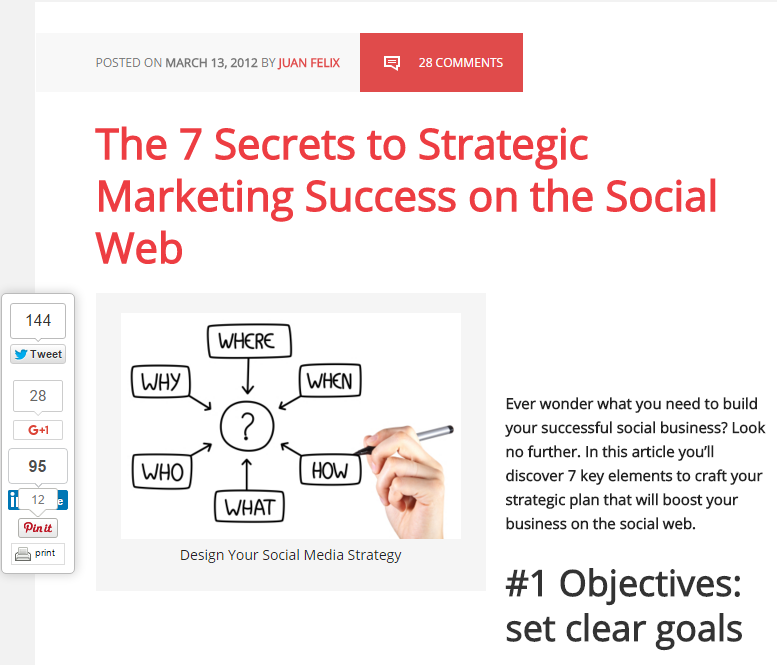
Juan Felix approaches a sensitive subject regarding the average reach on social media. Given that most of the companies are unhappy about their engagement rates, fans and buzz, the main mission is to start changing the status quo. Great stories are the ones that generate emotions, particularly when the tone is clear and your overall strategy is very well defined. Start with a comprehensive picture of your audience’s ‘profile’ if you want to engage them. And whenever you achieve success, monitor the key factors that led you to it and make it permanent.
6. 5 Reasons Why Relationship Marketing Is Important in Business
Make Yourself Known and Liked, then Bring Something Unique
Kim Garst explains the importance of relationship marketing in business. It all starts with building awareness – you can’t be recognized and liked if people haven’t heard of you yet. Make sure you make a great entrance, word of mouth is one of the most powerful information instruments today. Create new business opportunities and never dare to leave a customer displeased. The more personal touch you add to your business, the more reliable you will be. Nobody likes a boring copycat. Also, once you’ve promised to be the best, do not disappoint.
7. How to Rock at Relationship Marketing like the Best Sales Pros
Your Marketing Efforts Should Be Customer-Centric, Not Company-Centric
Nathan Ellering thinks that content marketing is the bread and butter of relationship marketing when you’ve got a business that (also) takes place online. From sharing your secrets to finding something out of the ordinary to bring to the knowledge of your audience, this is the best and shortcut-lacking recipe to get people to care about your services. Finding commonalities and providing solutions may be interesting but not enough, but consistent content and useful calls to action won’t go unnoticed.
8. 5 Marketing Tips for Improving Customer Relationships & ROI With Better Communications
Customers Are Your Brand-Advocates-to-Be
I was going through Ashley Zeckman‘s article on how crucial communication is when you want to engage your customers. From content to product design, pricing offers and the FAQ page on your site, everything should be customer-centric. And not just because they may pick the competitor instead of you, but because business isn’t done by people who buy your products or services once. A sustainable business will not fail to commit. Engaging in providing the most personal support for online customer service and constantly working on improving your communication makes a statement on how devoted you are to your business ideas. Always seek for innovative ways to showcase the needs of your team.
9. How to Build Better Business Relationships
Like Any Other Business, The Relationship Marketing Requires a Lot of Time and Has to Be Mutually Beneficial
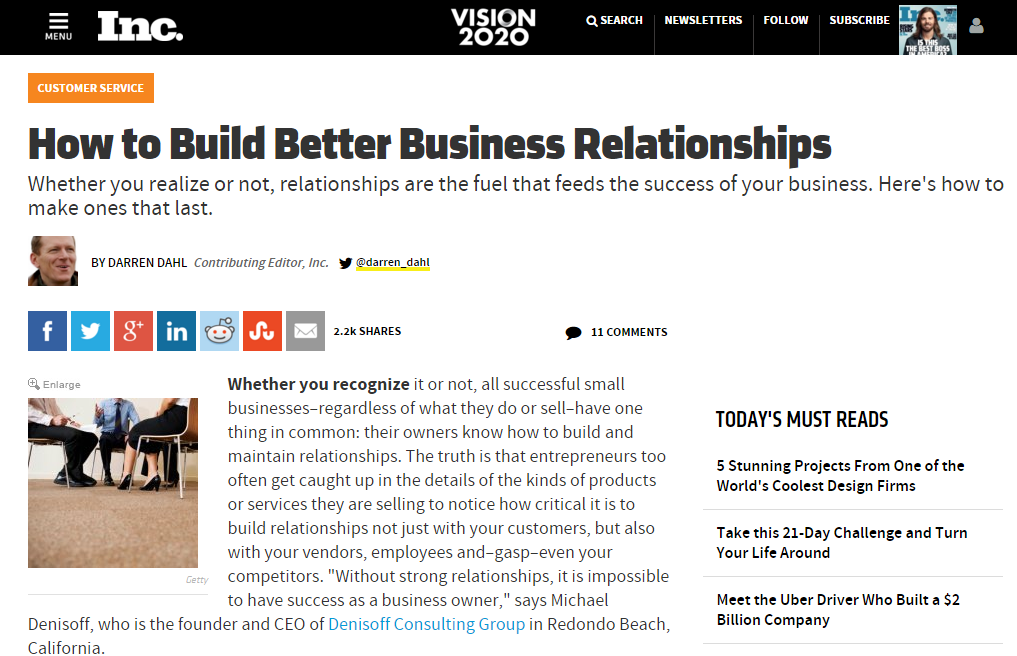
Darren Dahl suggests starting with listening to any honest feedback. Before taking any action, stop for a bit. Get a notebook/and take notes when you’re meeting someone of interest. Getting back to the office, add those to a contact list with detailed information and specific keywords to remind you of their stories. Be personal and honest. Meet face to face with your customers, and try not to look pretentious. Don’t try to look like a robot – people aren’t so fond of those. Instead, look human, show vulnerabilities, make jokes. Be yourself – the professional.
10. 5 Considerations for Building Strong International Business Relationships
Main Takeaway – Leverage the Technical Evolution in Building Credibility
Louei Ali doesn’t think we should take all the technical evolution that’s constantly happening around us for granted. I second that. And there’s no better way of showing how grateful you are to have new instruments at your disposal than using them right. Be as transparent as Joey’s (F.R.I.E.N.D.S.) humor in your communication processes. Adapt your offerings to the global customer demand and share your knowledge with the partners who travel towards fulfilling the same purposes. Last, but not least, trust should accompany your every move – both received and given.
11. How Co-Creation and Relationship Marketing Can Improve Your Business
With Technology on Your Side, Real-Time Customer Feedback Is Your Friend
There are examples of co-creation marketing innovation that Matt Crawford brought to our attention to suggest that the primary objective of relationship marketing should be leveraging customer data. This includes both the information that you’ve already got and the tech-based ideas the author indicates for visible improvements. From social media listening and the associated instruments to friendly webpages created following the customers’ needs co-creation is all about the right message through the appropriate channels.
12. The Business Case for Building Real Relationships with Customers
Facts of Relationship Marketing and How to Use Them in Your Favor
Gregory Ciotti makes it clear: customer service, content, social media, email, loyalty programs and surveys are the foundation of successful relationship marketing. The latter is where experience turn to word of mouth and expansion happens without any cost of acquisition. It is because it now costs 6 or 7 times more to attract new customer than to engage the existing ones which makes relationship marketing worth it. It does take reciprocity and personalization to achieve this great purpose, but at the end of the day building a relationship with your customers is about helping them.
13. 8 Tips for Relationship Building in Business
Relationship Marketing Is a Selfless Pursuit Governed by the Laws of Business Intelligence
Neil Fogarty finds and debates the 8 rules that he considers essential to relationship marketing. The first one sums up pretty well the entire idea of relationship marketing: ‘Before Asking for Something, Offer Something’. It’s not an easy job to be a professional friend, to always be prepared and know what lines should(n’t) be crossed. To know who is influential is to treat everybody as if they were – position and influence don’t always go hand in hand. Emotional intelligence and careful listening only work as long as you also keep your word. Practice what you preach and success will be your business story.
14. Five Relationship Marketing Strategies that Work
Market Your Brand Through Strong Existing Relationships
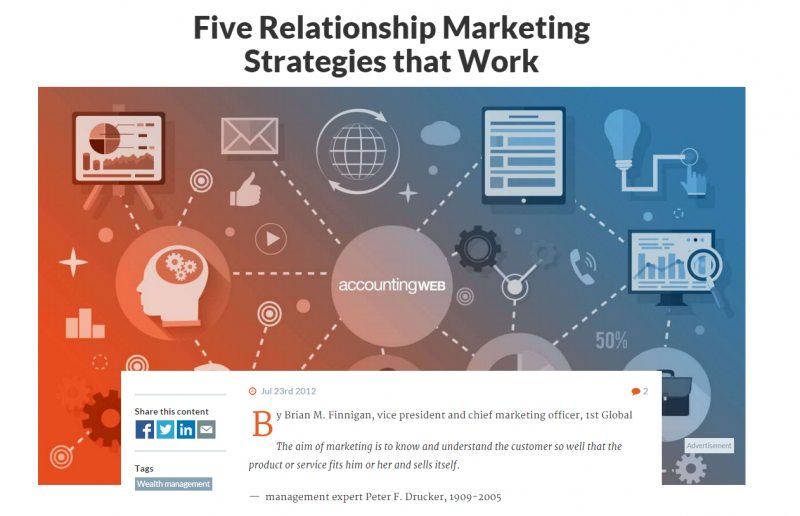
Brian M. Finnigan recommends applying 5 relationship marketing strategies in tandem to maintain and improve your existing customer relationships. Of course, your stakeholders aren’t limited to your customers, but the latter category is the most common, so we’ll refer to this one. Networking helps you to gain organic engagement. Introductions make the world go round – the power of referrals is never to be underestimated. So treat your clients as equals and organize high quality events to organically attract people in your niche. Your website and the communication system should be no exception when it comes to top-notch services. Make sure everybody is satisfied and your ROI will show you how much that matters.
15. What Is Relationship Marketing
Retain Long-Term Customers and Increase Referrals
Jordan Skole shares the importance of brand experience, which is people knowing the faces behind your logo, understanding your professional story from a personal perspective, knowing they interact with people who care and not with robots. Maintaining relationships with long-term customers increases the chances to get meaningful referrals. Plus, one of the most searched-for feature when choosing a service over another is having the chance to offer feedback that is going to be taken into consideration for that customer’s better experience. Offering this opportunity at every step gives you a competitive edge, which is worth its weight in gold when everybody’s trying to shift from the selfish traditional marketing.
16. Relationship Marketing 1-2-3: Why Building Relationships Matters Most
Increase Your Brand Experience
R. Kay Green recommends 7 basic rules to stand by when nurturing your clients into loyal customers. Assert yourself through professional engagement and updates of your accomplishments. Be active constantly and don’t disappear from the interest map of your clients, and remember that social media is merely a complementary means to solid marketing pursuits. Know your clients inside out – from their pet names to their middle names. If you’re trying to send the message that you’re in for the long haul, don’t forget that relationship building is something you should work on every day. Happy clients are the ones who make referrals. It’s in your best interest to keep them close, especially when they’re changing jobs.
17. Building 4 Key Relationships Every Content Marketing Strategy Needs
Research Is Your Friend in Making New Allies
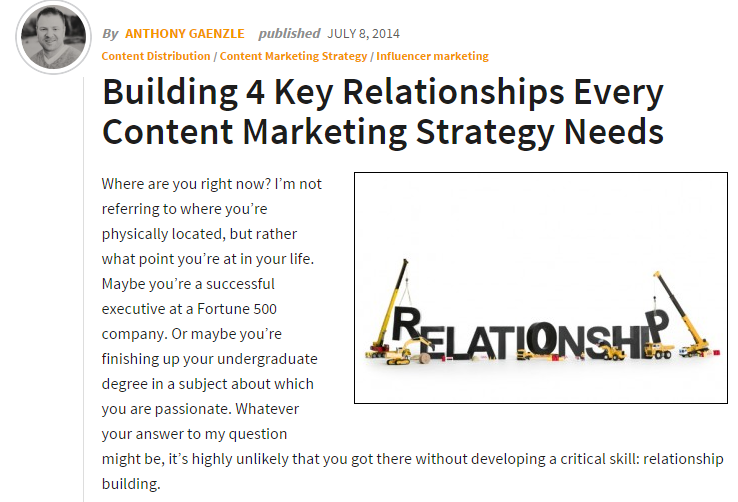
Anthony Gaenzle believes that closely monitoring your competitors can give you a significant competitive edge. Start from there. Research well, do your homework and don’t forget to share the results. Be transparent about it and transform your audience into a community. The more your ideas resonate with their needs, the more loyal they will become. Don’t forget planning and scheduling ahead if you don’t want to leave people with the impression that your efforts are chaotic and selfish.
18. Building Customer Relationships (6 Tactics)
Your Customer Service Should Be Legendary
Ross Beard shares 6 tactics to build long-term customer relationships that make a difference. There’s nothing you can do without not arbitrarily knowing, but studying your client first. Don’t forget that negative feedback is always the most useful, since it gives you an honest perspective on what should be improved – keep those complaints in mind and put them on your road map. Be realistic about your solutions and keep a regular contact with your customers if you want to know their honest feelings. Like any other life-long partnership, and customer loyalty is best built with lots of patience and commitment.
19. 7 Experts on Why Building Your Email List Is So Important
Make Email Marketing Your Friend
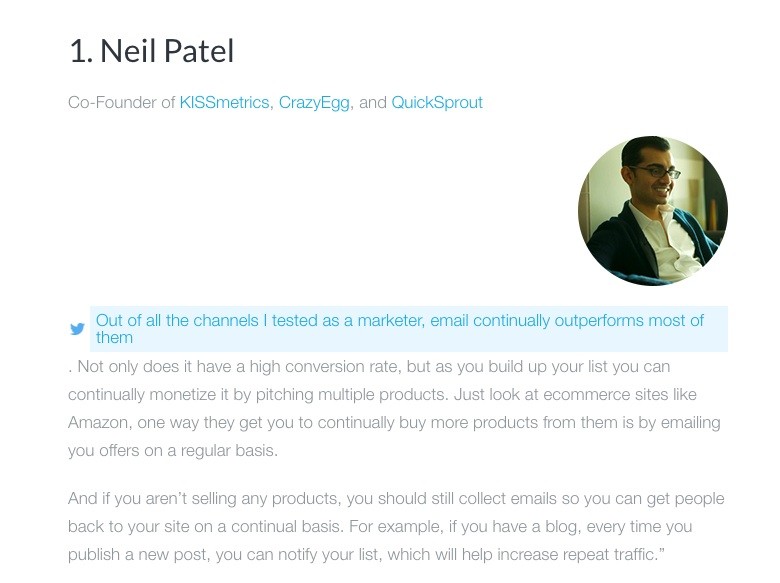
Aaron Beashel presents 7 experts on successful email marketing techniques. It’s worth investing in such an ongoing challenge because it converts more than most of the marketing techniques if you’re sure of three things precisely: what you should be addressing, when and how. Driving people on your site on a continual basis is one of the biggest assets on driving new acquisitions. It’s critical to include your name in any marketing pursuit, so that people keep in mind a strong brand figure. Make checking emails a Christmas morning with presents to be opened and your customers won’t forget who you are.
20. 17 Social Marketing Experts Share Relationship Building Tips
Customer’s Needs: Conversations and Relationships, Real Interaction
Jasmine Henry gathers the opinion of 17 most respected figures in Social Marketing to make a strong point: brand experience is all about creating a personal relationship with your customers, very much like the one we have in mind when making new friends. Engage with your clients from a position of expertise and you’ll have their professional trust – if you’re not smug about it. Be consistent and deliver a personal touch along with every message. Engage and support; offer technological solution of high-end performance and maintain relevance. And remember that there is no strong brand without a powerful story.
21. Why Relationship Marketing Is the Key to Your Content
Relationship Marketing Fuels Content
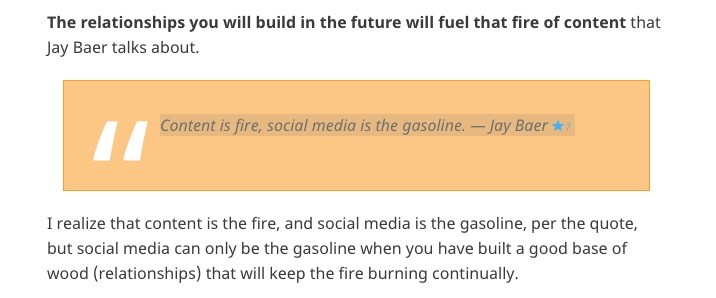
Wade Harman approaches the importance of correct, selfless social media engagement. 42% of the customers expect to be answered in less than an hour. Understand what emotional attitude your audience wants you to adhere to and don’t fail to deliver. Make yourself available at any price and keep in mind that social media presence should be all about helping and servitude.
22. Build Audience Connections with Content Marketing
Content Marketing Builds Relationships Through Trust and Expertise
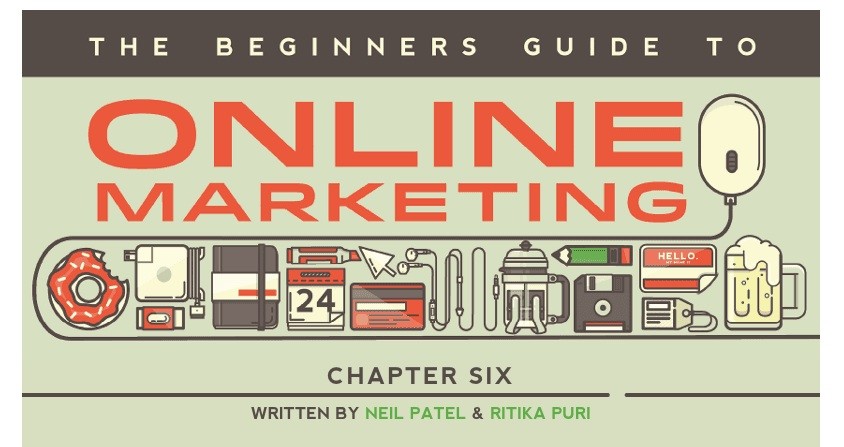
Ritika Puri and Neil Patel both agree that finding a system and some standards is crucial in delivering content that engages. To do this, you should address the most relevant matters to attract, acquire and engage audience. Try to post content from people with expertise that truly have something to share that gives and immediate takeaway. The idea of relevance starts from the premises that you know your public inside out.
23. Relationship Marketing Techniques You Have to Nail
Leverage Your Relationship Marketing Game Through Social Media
Julian Diaz is convinced that social media relationships are the currency of digital marketing. From social butterflies to community organizers, everything grows organically if you’re dedicated and accurate. A saturated social landscape is a feeble reason not to engage new layers of audience, especially if you make it clear that being treated as the most relevant customer is the birth-right of your every customer.
24. The 5 R’s of Starbucks Relationship Marketing
Starbucks: Always Learn from the Best
Joseph Ruiz gives a recipe: to be successful, you have to recognize, have a relevant offer, reveal, redeem and reward. The theory is simple. Email marketing starts from the idea that every inbox is as crowded as you’d like your shop to be. Using visual means to make yourself stand out is necessary, mainly because it builds strong associations between your content and your brand, if treated consistently. Be clear, minimalist even and keep in mind that a little incentive goes a long way.
25 The Dos and Don’ts of Relationship Marketing
Focus on Free Will Investments
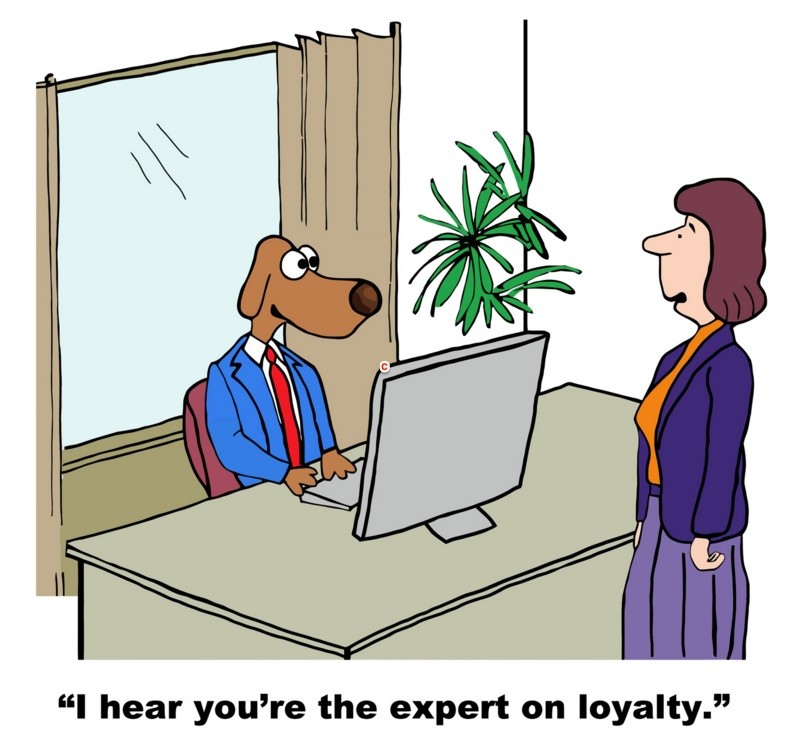
Josh Kraus seems to think that free will is not quite a commodity in relationship marketing. Most of the people with successful businesses often forget where they started from and push contractual obligations a little bit too much. However, there is a very strong connection between the feelings of gratitude of your public and the seller performance outcomes. Consumer trust and commitment should be at the bottom of this relational pyramid and relationship marketing investments should stop being seen as efforts for the sake of a blurry cause. Instead, generating loyalty is easier when people think you don’t only know their needs, but care about them as well.
26. Relationship Marketing: Focus on Customer Enablement Instead of Product Marketing Helps Toshiba Medical to Maintain Revenue in Shrinking Industry
Customer Enablement Trumps Product Marketing
David Kirkpatrick takes the example of Toshiba Medical in a case study whose conclusions can be easily extrapolated to any online business there is. The healthcare industry is very regulated and the rules are much harsher in the case of marketing pursuits. However, education is something we should all do life-long, and keeping yourself informed on your markets’ most obscure characteristics is a big part of the game. In the scheme of it all, a relevant event should reach out to and educate your public, the same way that you keep educated following trends. Always measure results to see where you’ve hit the jackpot and what you should work on in the future.
27. StartUp Social Media: Why Relationship Marketing Is Essential for Growing Your User Base
Create Awareness and Prevent Crises
Katie Leimkuehler makes a point on how hard it is to prove the impact and influence of your product and services. In this whole game, social media should be your partner in crime. Topical conversations along with strong content have the power to engage audience on any platform, if you’re creative and consistent enough. And if you deliver. Cultivating relationships takes time, but so does everything that is worth it. Besides constantly being there, listening and monitoring closely is also part of your job if you wish to be appreciated as a professional in the niche. Draw your conclusions and formulate pertinent techniques based on them. Don’t miss out on the relevant data that social media can provide to your business.
28. Relationship Marketing is Key to Your Business’ Success
Increase word of mouth referrals
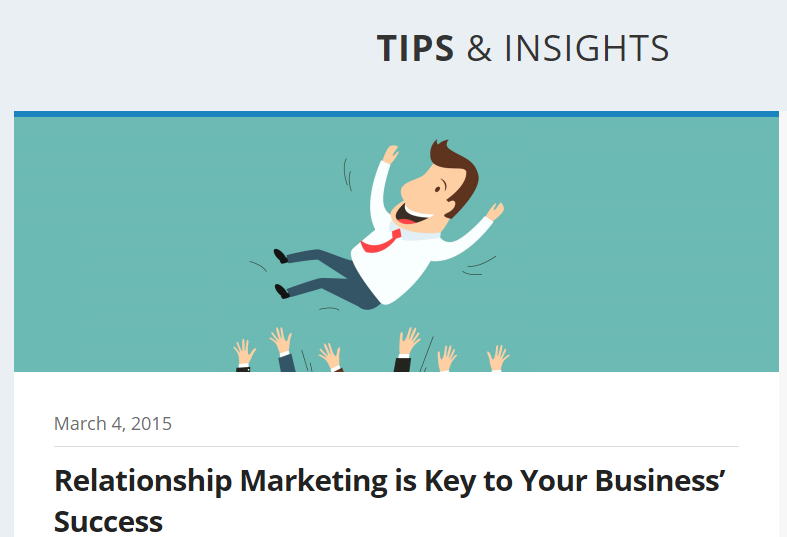
Fundivo‘s article focuses on how much more expensive it is to build new customers than engage and turn the old ones into loyal partners. The answer to this riddle is 6 times. Of course, there’s much effort in relational marketing than it is in the traditional, transactional one, but the results are completely worth it. Value your customers’ feedback and ideas and they will love your product; from being willing to pay more for your services to recommending them to everybody they run into, there’s nothing a pleased customer won’t do.
29. Relationship Marketing 101
Customer Oriented Marketing Works Wonders
Steven J. Adelmund shares his experience with relationship marketing, through four main ideas. He starts from the restaurant niche, but the conclusions apply to any other business at your choice: a) there isn’t such a thing as being too careful when it comes to your customers’ interests; b) your employees should be the embodiment of the message you wish to convey about your brand and nothing less; c) keeping your employees informed and instructed is the first step into achieving success; d) a sense of family felt by your employees will transmit to your customers as well, giving the personal touch that every business needs.
31. The ULTIMATE Guide to Relationship Marketing
Invest in Long-Term Profitability
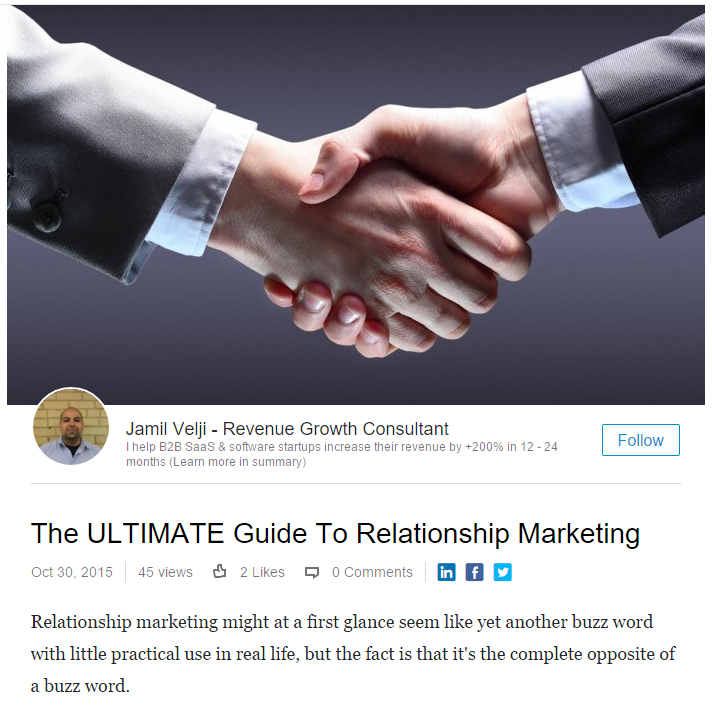
Jamil Velji has documented a complete guide to relationship marketing, from the definition and uses to the most valuable why‘s. As brand loyalty increases, pricing becomes less important. Additionally, people will recommend you among their circles and this is what the buzz you generate should be all about – gaining access directly to an audience that doesn’t only have a high intent, but a matching profile as your audience. The main disadvantage to take into account is the expertise involved to generate such a social engagement. It usually takes time and a lot of planning, but if you’re doing it properly the results are astonishing. Prove that you’re reliable and constantly underline the solutions that you’ve got for your customers’ needs. Be open and transparent about your practices and try to share some of your experiences. This latter method builds credibility and trust, as it also shows your human side. Customer service and social media are your best friends in this journey.
32. Relationship Marketing: Making the Emotional Connection
Make an Emotional Connection
Yvonne A. Jones believes that the emotional connection a brand creates with its customer is the milestone of competitive advantages. All lines of communication should be kept open, while creating top of mind awareness by continuously being in touch with your audience as a group and as individuals too. If your niche allows it, give your customers/clients the opportunity to know you personally. If it’s impossible, blog on a regular basis so that people know what you’ve been up to. Don’t leave out your latest professional experiences and credentials, as they are a confirmation of your status.
33. Relationship Marketing in Big Blue
Invest in a Portfolio of Relationships
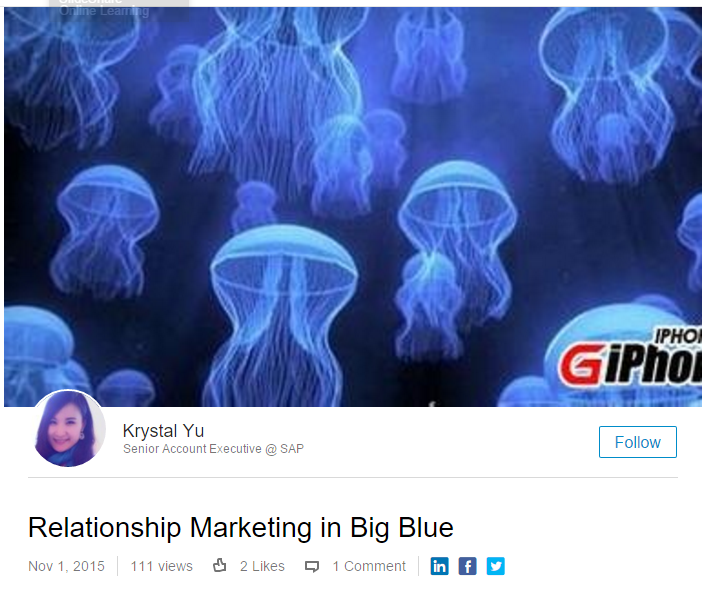
Krystal Yu addresses a case study on IBM. While there are some specific tactics that are part of the brand identity, most of the rules apply as much to the guy next door. Individual relationships have never been this important, as until recently brands were supposed to provide a product or a service instead of an experience. However, it is almost impossible to survive a relationship marketing pursuit without carefully initiating and developing strategic partnerships. Customer satisfaction is key when trying to generate loyalty, as is the personal approach. This technique is, indeed, consuming with regard to any of your resources, and you may encounter unexpected demands along the way. Once you’ve started this, you should deliver and actually take any feedback into consideration.
34. When Relationship Marketing Becomes Prickly
Digital Courtship and Strategic Planning
Greta Paa-Kerner makes a very good point underlining that there’s a fine line between always being there for your customers online and being creepy. We’re not trying to enact an Orwell play, we’re trying to be taken into consideration as customers. Regardless of the marketing technique that a company may prefer over another, the idea of marketing is a continuous pursuit. Having established that, personalization is what drives courtship to the next level: website optimized by device, personal promotional offers, price comparison capabilities, etc. While it’s important to know your customers’ behavior as intimately as possible, you should never use their personal information to achieve strategic results – it won’t last long. Take what you’re given and keep an eye on your audience. Be moderate.
35. How a Conversation Inspired a Relationship Marketing Campaign
You have a USP; what’s unique about your customers?
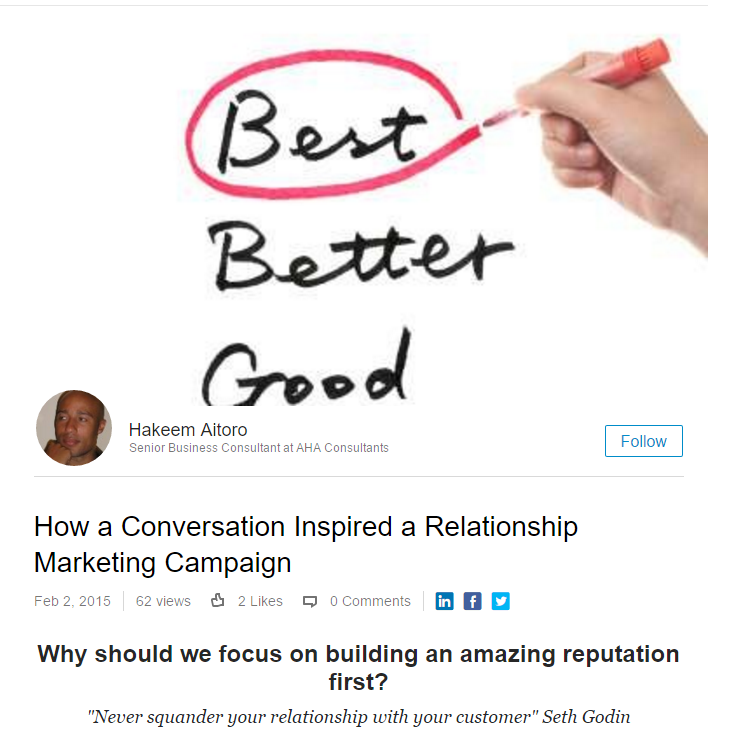
Hakeem Aitoro approaches this systematically: if your customers should choose you for your competitive advantages that separate you from the crowd, it’s common sense mutuality that you should also know something that individualizes your every customer. Cultivating a personal relationship with your audience isn’t an easy job, especially if you’re popular. However, treating people personally engages and builds loyalty. Offer additions to your products, ask people what their ultimate product-related experience would be, observe and learn from your competitors as well as people from other industries what it means to do a great job. See who managed to engage you and what strategies they used. Be watchful and don’t settle for ‘good enough‘.
36. Personal Relationship Marketing
Relationships Go Beyond Business
I agree with Joseph Pagano on the fact that the distinction between business and personal relationships are getting blurrier by the day, given the technological assault and the social media platforms that seem to erase any communication barriers. Start from here and cultivate the status quo. Don’t take your customers for granted and be personal in interactions. Generate prospects by cultivating personal relationships – you don’t have to have dinner with all your customers, but a birthday card didn’t kill anybody.
37. Relationship Marketing & the Future
Platform Engagement Is Your Friend
John E. Walker notices that a growing use of text in communication represents the symbol of the social media era. From texting messages when being with friends to the regular check-in, nobody lets their smartphones battery last too long. So it’s only fair to presume that text optimization is where we should all start from. Create engaging content from email marketing to Facebook posts and tweets. Attract people’s attention. The following step is to maintain your audience engaged through personalized messages and business approaches.
38. Ignore the Human Element of Marketing at Your Own Peril
Your Brand Is Forever Entwined in Relationships
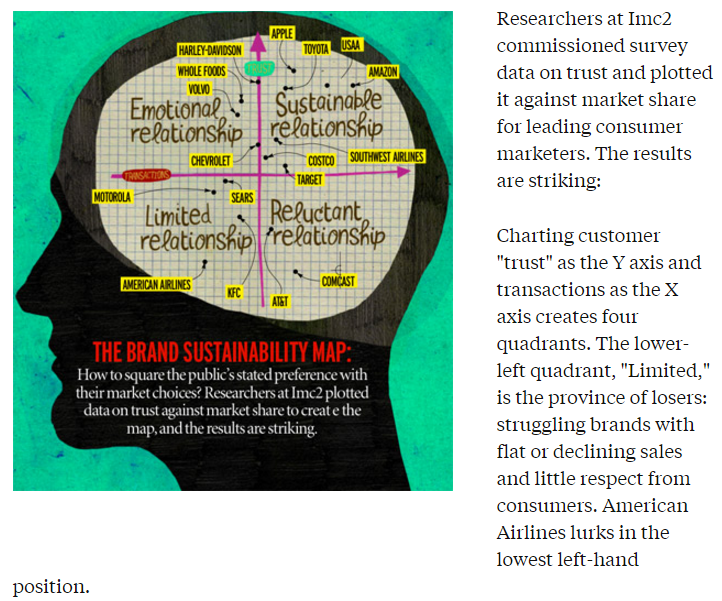
Bob Garfield notices that there are two main points to be raised: a) people love brands (hopelessly so) whether you like it or not and b) your brand is no exception to this rule. So the best you can make of this is to try as hard as your resources allow it to build trust. Maybe you won’t be Harley Davidson, Volvo or Apple, but an emotional relationship is also part of this equation. Imagine two axes: one representing brand respect and the other one the amount of generated emotion. Ideally, you’ll be an ace on both of these. Awareness, opinion, consideration, preference and purchase have started to be accompanied by advocacy. Given that core values can’t be faked, you may want to start working on a sustainable marketing development plan.
39. Your Customers’ Stories Improve Your Products. And Marketing
Let Your Customers Do the Storytelling
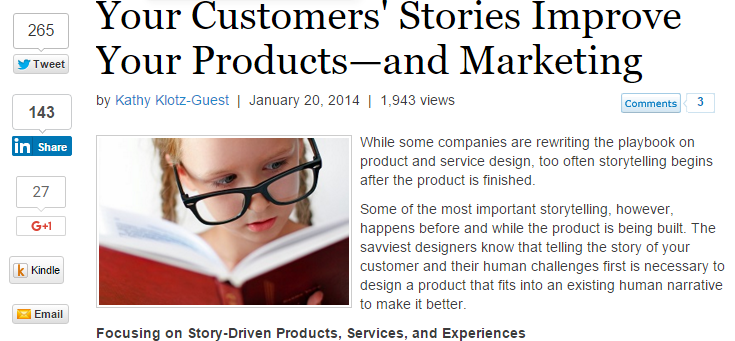
Katy Klotz-Guest strongly suggests focusing on story driven products, services and experiences, as branded names often come up in the daily narrative of happy customers. Besides talking among them and enlarging your networking, your customers can always inspire you to create design and artwork having their ideas/opinions/experiences as starting points. But don’t stop here: listen to the feedback and seriously take it into consideration when launching new products/services. You may have a pleasant surprise. As the author underlines, at their best product stories are not positioning after-thought, but the inspiration behind product innovation.
40. Why Relationship Marketing Is the New Model for Luxury Brands
Reconnect to Your Core Values Through Digital Tools
Nicolas Chabot implies that it is no longer enough to be innovative and exclusively driven by premium pricing and social prescription. It takes emotion to survive this new paradigm of luxury (which, I may add, extends to any other brand type). The two pillars of this business paradigm are: a) brand platforms focusing on building a unique brand image and creating a sense of exclusivity and social aspiration and b)having developed integrated business distribution networks. This milestone has, however, suffered a mutation – the infiltration of emotion in every sector and stage of business interactions. Constantly and consistently engaging with customers, being omnipresent on social platforms, cultivating relationships are the new directions to be followed. And they’re a must.
41. 4 Tactics to Create Brand Loyalty Through Relationship Marketing
Building Trust Trumps Being a Professional
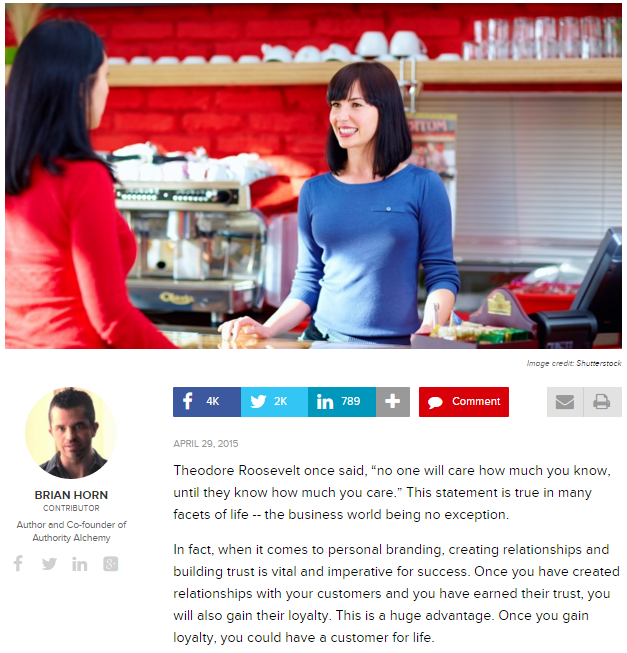
Brian Horn believes that the most fortunate case scenario includes a professional who’s genuinely interested in building organic relationships for networking purposes, which additionally will constitute business intelligence and convert. He also puts 4 ideas on the table for the brand managers interested in long-term, sustainable relationship marketing. Returning customers should be offered discount on services, as this would acknowledge your appreciation, and reward references should be implemented, as gratitude. Updates aren’t only to be posted on social media, but whenever the situation allows it, you could try being more personal with your audience as well. Faking a genuine interest in your audience’s trust will do more harm than good, so the first thing to be taken into consideration is being honest and transparent.
42. 5 Ways to Build Trust When Mixing Social and Marketing
Building Trust Trumps Being a Professional
Joseph Ruiz believes that the marketing mindset should be oriented towards social media. Trust is one of the purchase pillars and personal opinions on brands are very well guarded territories. If you’re privileged enough to have entered a consumer’s circle of trust, there are some things you should follow religiously. Relevance isn’t optional, neither is knowing your audience when you’re trying to transmit that your intentions are of serving rather than just selling. Consistency builds engagement and long-term communities of loyal partners, as long as you’re honest and genuinely interested, monitoring their every reaction.
43. The Essential Guide to Trust in Marketing
Increase Conversions and Extract Maximum of Value
David Rosenfeld advocates trust as being the most essential factor in generating profit. Despite having the best product/service in your niche, lack of trust will strike with no regret. However, the first two steps when looking to achieve trust among stakeholders are a) transparency and b) talk about your best practices. While the first step is pretty much intuitive, the second implies writing case studies, documenting happy stories, using testimonials and endorsements. It goes without saying that ‘selling’ trust as a marketing advantage shouldn’t be an act. While promoting your business as being transparent and customer-oriented, delivering every promise should be your primary concern.
Conclusion
Today, marketing revolves a lot around trust. Business intelligence requires relevant experience and credibility in order to convert, maintain and develop professional relationships. Giving the impression of running company-centered marketing campaigns is unforgivable, as the audience seeks for a personal, emotional experience more than just a product that robotically satisfies a list of needs. Just like you use the competitive advantages you’ve got to separate yourself from the competitors, your customers and business audience would like to know they are unique in relation to you. Your permanent marketing pursuit would have to start from this premise to even have a chance. Listen to the feedback you’re given and try to implement it as much as possible, as the most honest purpose of every marketing endeavor should be fostering target loyalty – from the partners you’ve started the business with to the future customers that haven’t even tried out your product yet. And remember – everything is expendable in business, don’t give up.

 Site Explorer
Site Explorer Keyword tool
Keyword tool Google Algorithm Changes
Google Algorithm Changes

Leave a Reply!